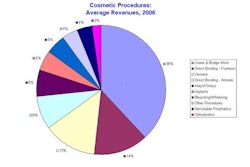Dentists can make many patients happy by lengthening their crowns, according to James Kohner, D.D.S., a Scottsdale, AZ, periodontist who specializes in the procedure. "We can make significant changes in the way people look at themselves," he said. "I think it can be life-altering."
“We can make significant changes in the way people look at themselves. I think it can be life-altering.”
He recounted the case of a shy patient who always held her hand in front of her mouth when she smiled because so much gum showed. After lengthening her crowns, Dr. Kohner ran into her in a grocery store. "I think it did change her life," he said. "She was bubbling and giggling and actually smiled."
To help present a case for aesthetic crown lengthening to patients, Dr. Kohner, speaking at the fall meeting of the California Dental Association, recommended downloading photographs from www.perio.org.
Crown lengthening in the aesthetic zone presents many challenges, he said, and he cautioned that general dentists should attempt it only with great care. "It's tricky," he said. "I've had two instances of general dentists giving me horror stories."
But even if you refer to a periodontist, it's essential to understand how the procedure works and who is eligible, Dr. Kohner said. The key is biologic width. "The most important thing to know before you start is where is the bone," he said. "Is it a normal crest? Or is it a high crest?"
Most patients have about 1.07 mm of connective tissue, 0.97 mm of epithelial attachment, and 0.69 mm of sulcus.
If the crown margin to bone crest measurement totals more than 3 mm, a patient can have crown lengthening without bone reduction; it's simply a matter of cutting away the excess gum. "But this is the vast exception," he said. "In 35 years, I have had no cases where I could just do gum removal without bone removal."
Most patients have 3 mm or less, so the bone must be reduced. Otherwise, the gum will grow back. "The tissue is the issue but the bone sets the tone," Dr. Kohner said.
That's why it's essential to numb the patient and probe the distance from the crown margin to the bone crest. "If you go awry with your planning, you can get into trouble very quickly," he said. Once you have that measurement, you can determine how much bone to remove based on the desired length of the crown. The measurement may also depend on the restoration.
For aesthetic crown lengthening, Dr. Kohner cuts a labial flap. He's careful to preserve interproximal tissue and flap thickness.
For the osseous surgery, he starts interproximally. He prefers a round bur, and has some custom made by Charles Rode of Southern California.
Dr. Kohner prefers not to do his surgery from templates provided by the general dentist; he'd rather work with measurements. "The plastic has little burs and extrusions," he said.
He disputes the assertions of some laser companies that the surgery can be done without cutting a flap. "The problem with closed-flap surgery is visualization," he noted.
Dr. Kohner also questioned the assertions of some laser manufacturers that laser surgery avoids the need for anesthesia. "I tried it," he said. "The patients said, 'Ohh! Ahh!' "
Copyright © 2008 DrBicuspid.com



















